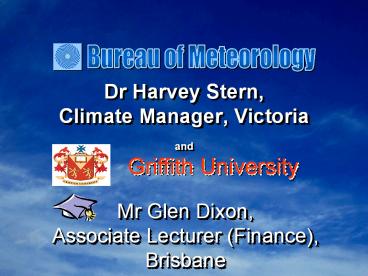Dr Harvey Stern, - PowerPoint PPT Presentation
Title:
Dr Harvey Stern,
Description:
Introduction Evidence of the challenge faced by the meteorological community to become ... Australian Agricultural and Resource ... Bureau of Meteorology – PowerPoint PPT presentation
Number of Views:127
Avg rating:3.0/5.0
Title: Dr Harvey Stern,
1
- Dr Harvey Stern,
- Climate Manager, Victoria
- and
Griffith University
Mr Glen Dixon, Associate Lecturer (Finance),
Brisbane
2
Australian Agricultural and Resource Economics
Society, Queensland Branch Brisbane (DPI),
Friday 27 September 2002
Pricing Weather Derivatives in the Australian
Agricultural Market
3
Introduction
- Evidence of the challenge faced by the
meteorological community to become skilled in
applying risk management products from financial
markets is growing. - An empirical approach to the pricing of
weather derivatives is presented. The approach is
illustrated with several examples with focus on
Agriculture.
4
Outline of Presentation
- The increasing focus on weather risk.
- Weather in company reports.
- Mitigating weather risk.
- New developments.
- Quantifying uncertainty in forecasts.
- Ensemble forecasting.
5
Background
- Weather risk is one of the biggest uncertainties
facing business. - We get droughts, floods, fire, cyclones
(hurricanes), snow ice. - Nevertheless, economic adversity is not
restricted to disaster conditions. - A mild winter ruins a skiing season, dry weather
reduces crop yields, rain shuts-down
entertainment construction.
6
Weather Climate Forecasts
- Daily weather forecasts may be used to manage
short-term risk (e.g. pouring concrete). - Seasonal climate forecasts may be used to manage
risk associated with long-term activities (e.g.
sowing crops). - Forecasts are based on a combination of solutions
to the equations of physics, and some
statistical techniques. - With the focus upon managing risk, the forecasts
are increasingly being couched in probabilistic
terms.
7
First Weather Derivative in Australia
- It is the energy and power industry that has,
so far, taken best advantage of the opportunities
presented by weather derivatives. - Indeed, the first weather derivative contract
was a temperature-related power swap transacted
in August 1996.
8
First Weather Derivative Payout in Australia (1)
- Two temperature-based options contracts, which
are claimed as Australias first weather
derivatives deals, expired at the end of March
1998 with a pay-out for the purchasing party. - US Electric Utility Utilicorp sold the options to
United Energy Marketing in late January, with a
profit for United if during February and March
temperatures hit - 35 deg C or above on 5 days or more in
Melbourne, Victoria or 33 deg C or above on 3
days or more in Sydney, News South Wales. - Source Energy and Power Risk Management
June, 1998
9
First Weather Derivative Payout in Australia (2)
- By the end of March, temperatures had hit the
required level on 5 different days in Sydney, and
6 days in Melbourne, triggering payouts. - Alan Rattray, VP of International Risk Management
of Utilicorp Australia said the Sydney contract
returned eight times the premium paid. - Source Energy and Power Risk Management
June, 1998
10
Weather Derivatives Defined
- Clewlow et al...(2000) describe weather
derivatives as being similar "to conventional
financial derivatives, the basic difference
coming from the underlying variables that
determine the pay-offs", such as temperature,
precipitation, wind, heating degree days, and
cooling degree days.
11
Weather Derivatives
- Weather derivatives are similar to conventional
financial derivatives. - The basic difference lies in the underlying
variables that determine the pay-offs. - These underlying variables include temperature,
precipitation, wind, and heating ( cooling)
degree days as described by Clewlow and
Strickland.
12
Pricing Methodologies
- Historical simulation (look at examples using
this technique). - Direct modeling of the underlying variables
distribution. - Indirect modeling of the underlying variables
distribution (via a Monte Carlo technique as this
involves simulating a sequence of data).































